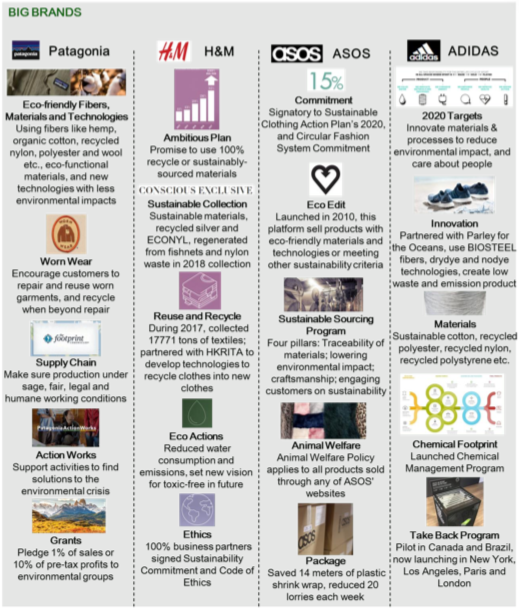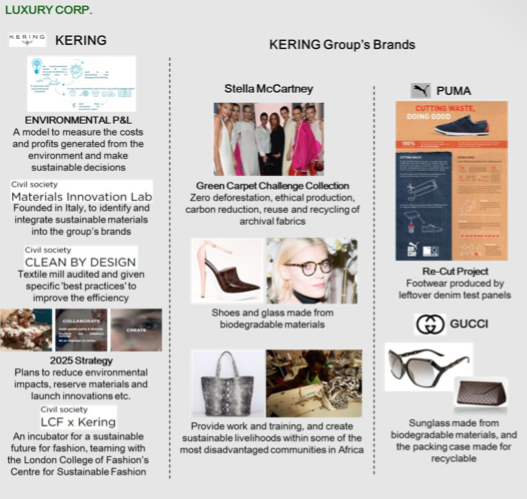Patagonia, a US brand for outdoor and salient sports clothing, has been recognized as one of the most outstanding pioneers dedicated to environmental protection. The company encourages using eco-friendly fibers, including hemp, organic cotton, 100% recycled down and innovative technologies to reduce unnecessary harm to the environment1. Furthermore, Patagonia initiated various sustainable ways to identify its differentiation. Worn Wear, a special hub for keeping materials in use, encourages customers to share stories about their own fashion products, to keep their worn wears in action longer through repair and reuse, and to recycle them when beyond repair. This much-perceived program does more than just educating the concept of conscientious consumption to consumers and gradually cultivating a loyal and highly engaged customer base, also sets a good example to the industry for a model of the circular supply chain. The Footprint Chronicles, another initiative from Patagonia, is designed to make sure its supply chain is performing under safe, fair, humane and legal conditions, whereas Action Works is to engage with the community and support activities to help to solve various environmental crises. Patagonia’s founder even co-established the initiative of One Percent for the Planet – an organization conceived to encourage business to donate 1% of sales or 10% of profits to environmental groups.
H&M, one of the leading fast fashion companies, has been actively engaged in sustainable fashion movements in recent years. Earlier this year, the H&M group published its Sustainability Report 2017 detailing important progress and strong commitment towards its vision to lead the change towards a circular and renewable fashion industry, while being a fair and equitable company. In this report, it outlines an ambitious plan to use 100% recycled and sustainably-sourced materials by 2030. Launched for several years, Conscious Exclusive is a most sustainable collection in H&M’s product line, providing ethical fashion products made from sustainable materials. For example, recycled silver and ECONYL – raw material generated from fishnets and nylon waste are exclusively used in its 2018 collection. The company also rapidly develops programs for reuse and recycling – a total of 17,771 tons of clothes had been collected from their stores in 20172. In Hong Kong, H&M partners with the Hong Kong Research Institute of Textiles and Apparel (HKRITA) to develop new technologies to upcycle used clothes into new ones, and the pilot operation in Hong Kong has started in September this year. For production processes, the group promise to reduce water consumption and gaseous emissions and will set a new vision for toxic-free operation in the future. To ensure safe and fair working practice, it requires all of its business partners to sign Sustainability Commitment and Code of Ethics.
In Hong Kong, H&M partners with the Hong Kong Research Institute of Textiles and Apparel (HKRITA) to develop new technologies to upcycle used clothes into new ones, and the pilot operation in Hong Kong has started in September this year. For production processes, the group promise to reduce water consumption and gaseous emissions and will set a new vision for toxic-free operation in the future. To ensure safe and fair working practice, it requires all of its business partners to sign Sustainability Commitment and Code of Ethics.
ASOS, the UK based online ultra-fashion company, starts to play a leading role in sustainable fashion movements. As the signatory to the Sustainable Clothing Action Plan’s 2020 Commitment and Circular Fashion System Commitment at the Copenhagen Fashion Summit, ASOS makes a set of targets regarding carbon, water and waste footprint reduction and circularity establishment. Within the asos.com website, a curated destination Eco Edit sells products made by manufacturers and brands with strict sustainable business practices, and the revenues of these items are designated to support related areas of sustainable fashion. A sustainable sourcing program is launched to achieve the traceability of raw materials, lowering environmental impact, investing craftsmanship and engaging customers on sustainability. ASOS carries out the Animal Welfare Policy across all its product lines. As an online company, it also dedicates to manage packaging waste and transport efficiency. It is reported that the company sourced over 40 million plastic mailing bags and 5 million cardboard mailing boxes a year. To reduce transport footprint, ASOS made a change in parcel packaging and reduced 14 to 20 trucks from the road each week
3.
Adidas, being a global sports clothing and footwear company, has a long history of nearly 30 years for sustainable development, especially in its supply chain management. It develops a Sustainability Roadmap to translate the company’s sustainable efforts into tangible goals and identifies strategic priorities from clean production to people catering. Adidas builds up innovation teams to focus on materials and manufacturing processes innovation, for example, using oil-based plastic to reduce carbon emissions, adopting waterless dyeing to save water, chemicals and energy. The company also sourced more sustainable materials such as recycled polyester/rubber, organic cotton, and TENCEL. Their manufacturing suppliers are committed to recycling a high proportion of operation waste back into production. Since 2015, Adidas partnered with Parley for the Oceans to support ocean conservation. Besides funding support for activities, Adidas launches Parley Ocean Plastic, a range of eco-innovative materials generated from upcycled plastic waste collected from remote shorelines, beaches and coastal communities. Adidas has been running chemical management program for years to systematically supervise product safety, environmental audit, chemical input, disclosure and partnerships. To form a circular system, the company launches the Take Back program in Canada, Brazil, New York, Los Angeles, Paris and London as pilot cities to collect clothes and shoes from any brand, raising awareness of consumers and sending the discarded products for reuse or recycling4.
As the founding partner of Global Fashion Agenda, the French luxury group Kering and its fashion brands are leading the sustainable luxury fashion for years. The Group develops an innovative tool Environmental Profit & Loss to measure the cost vs benefit generated for the environment, and in turn, making more sustainable business decisions across the entire supply chain. The methodology is now open sourced for other companies. In 2013, Kering founded the Materials Innovation Lab in Northern Italy to identify sustainable raw materials for luxury standards and enable the Group’s brands to integrate the materials into their collections. It also launches a Clean by Design program initiated by the Natural Resources Defense Council to audit the Group’s textile mills for clean manufacturing from spinning, weaving, dying to finishing. Teaming with the London College of Fashion’s Centre for Sustainable Fashion, an incubator was established to connect research, education and business to accelerate innovative design for sustainable fashion for the future. Just before Copenhagen Fashion Summit 2017, Kering released its 2025 sustainability goals, which mainly aim to prioritize transparency, to use new raw materials and to clean up the entire supply chain.
With sustainable strategies and management of the Group, Kering’s fashion brands are playing important roles in sustainable luxury fashion within the industry. Before her split with Kering in 2018, Stella McCartney was one of the most outstanding pioneers in promoting sustainable fashion for the Group. Among the first for green carpet, Stella McCartney launched her capsule Green Carpet Challenge collection in 2014 London Fashion Week, with zero deforestation, ethical production, carbon reduction, reuse and recycling of archival fabrics. To replace leather, she used innovative bio-synthetic materials for shoes and bio-plastics for eyewear, which was then expanded into her fashion collection. Furthermore, Stella McCartney created a range of hand-made recycled canvas tote bags and engaged more than 100,000 people in the most disadvantaged areas in Africa to work from printing to stitching for sustainable livelihoods.
Within the Kering Group, PUMA collaborated with its denim partner Saitex to run a Re-Cut Project and use the test panel denim waste for the uppers of footwear. From the beginning of the lifecycle, the denim cutting down waste is designed to be sent to the end of the footwear’s cycle, which sets a good example for closing the loop across the supply chain. All the profits gained from this collection go to support the local venture in Vietnam for medical care and food in the orphanage.
To share Kering Group sustainable responsibility, Gucci launched an innovative sunglasses model made in liquid wood, a biodegradable material, representing an alternative to the plastic. Certified recyclable packaging has been used for Gucci brand eyewear, with an instruction for the customers on how to return the case to the recycling centers.
Some leading companies have set specific sustainable targets across the supply chain, from materials, resources, manufacturing, recycling to ethics and others. The table below lists the detailed targets of Kering, H&M, ASOS, Adidas and Eileen Fisher.
- https://www.patagonia.com/recycling.html [22-07-2018]
- https://about.hm.com/en/about-us/in-focus/sustainability-at-the-centre–rewearreuserecycle.html [22-07-2018]
- https://www.asosplc.com/~/media/Files/A/Asos-V2/documents/corporate-responsiblity/reporting-and-policies/asos-ghg-report-2016-17.pdf [24-07-2018]
- https://www.adidas-group.com/en/sustainability/managing-sustainability/general-approach/ [25-07-2018]


